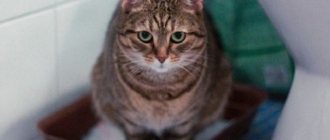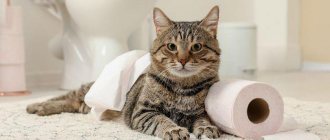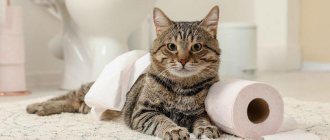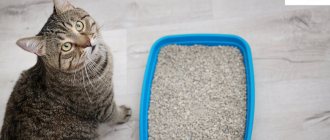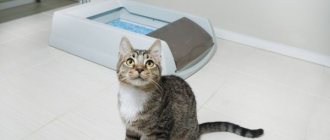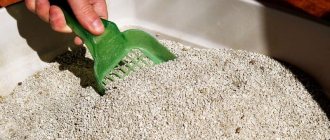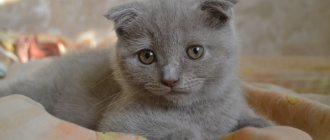Frequent urge to urinate in pets is called polyuria. This is a commonly diagnosed pathology that occurs in cats. The water-electrolyte balance of domestic cats, like that of humans, is maintained at a level due to the work of the renal structures.
Polyuria is a pathological process based on the inability of the renal structures to process the volume of fluid that is in the body. In other words, if a cat experiences a frequent urge to urinate, this indicates problems in the renal system. In any case, you need to contact a veterinarian for help.
Causes of the disease
Urine excretion is a necessary physiological process through which metabolic products are removed from the body. A pathological condition in which a cat pees more often than usual indicates a malfunction of the urinary system and is called pollakiuria in veterinary medicine.
This term refers to excessively frequent urine output that goes beyond the cat’s daily norm while maintaining a normal volume. Pollakiuria is not an independent disease, but a harbinger of diseases of various organs and systems.
Pathological causes of frequent urination include:
- cystitis;
- urolithiasis disease;
- diabetes;
- urinary tract infections;
- renal and liver failure;
- prostatitis;
- bakvaginitis (in cats);
- malignant and benign tumors, due to which compression of the bladder occurs and its mechanical emptying;
- central diabetes insipidus;
- purulent inflammation of the uterus (pyometra);
- hyperthyroidism;
- Cushing's syndrome;
- kidney pathologies (nephrosis, amyloidosis);
- urinary incontinence;
- Addison's disease.
Often, a cat pees more often than usual due to stressful situations that he has had to endure.
A change of place of residence, the appearance of another pet in the house, noisy companies, and even a regular car trip to the veterinary clinic can negatively affect the animal’s psyche and lead to a reflex contraction of the bladder. When the cat calms down, he will go to the litter box as before.
Another factor in frequent urination is when cats reach a certain age when they begin to become sexually active. Leaving marks is normal and has nothing to do with illness. In this way, the cat shows that he is the master of his territory.
Other signs that trigger urine leakage include old age, extreme thirst, hypothermia, and taking certain medications (anticonvulsants, cortisone, diuretics, etc.).
Reasons of a physiological nature
If a cat often goes to the toilet a little at a time, you should not immediately consider him sick. It happens that such behavior is determined by reasons that are not related to the disease:
- external influences (most often temporary);
- physiological needs of the pet.
If your cat constantly sits down to pee, you should consider whether the animal is experiencing stress. This condition can be provoked by visits from strangers, the appearance of a new animal in the house, or rough treatment.
Another sign of stress is a change in your pet's appetite. At the same time, cats’ immunity drops sharply, which means the “doors open” for the development of various inflammatory processes that require mandatory treatment.
Important! If the cat pees often and little, or eats poorly, it is necessary to analyze the situation for the presence of stress and try to eliminate the cause. If blood discharge appears in the animal's urine, you should immediately show your pet to a doctor.
In hot weather, the cat often drinks water to protect itself from overheating. Therefore, if he begins to pee frequently (6-7 times a day), there is no need to worry. He does not require treatment. As soon as the heat-related need for liquid stops, the cat will gradually stop urinating frequently and will gradually return to its normal rhythm of life.
If an adult animal likes to lie down more than run around, or is overweight, the number of visits to the litter box can be reduced to 1-2 times a day. Physically active pets go to the toilet often and little by little, while cats urinate less often than cats.
Main symptoms
Signs of urinary dysfunction are visible to the naked eye: the cat pees more often than usual. If the volume of daily urine excretion is exceeded, then we are no longer talking about pollakiuria, but about polyuria. This can be understood by the litter in the cat's litter box.
For example, if you used to change it once a week, and recently - 2-3 times a week, it means that a serious failure has occurred in the cat’s body. For reference: the normal volume of urine excreted in an adult cat is on average 28 ml (about half a tea cup) for 2-3 visits to the litter box per day.
Frequent urination may be accompanied by other signs - increased thirst, discharge of blood and pus along with urine, fever, weight loss. Due to frequent urination, the water-salt balance is disturbed and the appearance of the pet worsens.
The fur on the hind legs, belly, and lower part of the tail is constantly wet, emitting an unpleasant odor. For cats, which are naturally very clean animals, this causes considerable discomfort, forcing them to constantly lick themselves.
It is worth observing the cat's condition. Perhaps the dry food is too salty or she has eaten too much of it. If pollakiuria is associated specifically with the diet, then within a day urination will normalize.
Frequent urination in cats
The way a domestic cat visits the toilet is considered the main indicator of the functioning of its body. A disruption to the usual rhythm never occurs without reason. Sometimes this phenomenon may be normal, but most often urination disorders indicate pathologies.
An important sign of a pet's health is its urination pattern, namely how often and how intensely the cat urinates. According to statistics, genitourinary diseases occur in pets of any age.
The rate of metabolic processes, which changes with age, determines the characteristics of the urination regime for each specific animal.
Table 1. How many times do cats go to the toilet, normal indicators depending on age
| Age | up to 3 months | from 3 months | after 4 years |
| How often does a cat pee (per day) | 1 | 2 | 3–5 |
If the animal is dry-fed, the volume of urine decreases.
Interesting! Sterilized cats sit on the tray more often, this is a need of their body.
Diagnostics in a veterinary clinic
To make a correct diagnosis, a veterinarian needs to conduct the necessary diagnostic tests. After a visual examination of the animal and collection of anamnesis, the specialist prescribes for the cat:
- blood and urine tests;
- Ultrasound of the kidneys, bladder, abdominal cavity;
- radiography;
- seeding on nutrient media (in case of possible bacterial infection);
- studies on the hormonal antidiuretic complex.
When conducting diagnostics, the veterinarian excludes factors such as increased salt intake, medications, and infusion therapy.
Treatment methods
As a rule, the doctor prescribes an ultrasound of the animal’s internal organs. If your cat often sits down to pee and is not thirsty, you will need to have his urine and blood tested. He may be referred for an X-ray examination.
Based on the results obtained, the doctor determines the diagnosis and prescribes individual therapy. Most often, domestic cats are treated with antibiotics, hormonal agents, and anti-inflammatory drugs. Sometimes antispasmodics and painkillers are necessary. Sometimes the only thing that can help your pet is surgery.
If tests show the formation of stones in the animal’s kidneys, the owner may be offered to operate on the cat. Later, the veterinarian prepares a special diet that excludes pathology-causing foods from the diet. During the treatment period, the cat is isolated from other pets.
Treatment method and prognosis
There is no single treatment regimen for pollakiuria. Therapeutic procedures are prescribed after diagnosis. As mentioned above, pollakiuria can be a sign of a dangerous disease, so treatment will be aimed at eliminating it.
Thus, for diabetes mellitus, insulin therapy is an important stage of treatment. With the help of drip infusion of polyionic drugs, the water-salt balance is restored. The key to successful treatment and recovery or maintaining quality of life at a satisfactory level is nutritional correction and quality care.
It often happens that the pet will be limited in physical activity for the rest of its life, take appropriate medications and eat exclusively special medicinal food.
If pollakiuria is caused by stress, then, first of all, it is necessary to eliminate the source of psycho-emotional stress. To reduce the negative effects of stress, your veterinarian may prescribe anti-anxiety medications, such as Stop-Stress.
Cat marks are an unpleasant phenomenon, but an animal cannot be punished for it. The best way out would be castration or the sedative phytohormonal remedy Kot Bayun.
Antispasmodics are indicated to relieve pain; antibiotics and sulfa drugs are used to eliminate infections.
The prognosis for pollakiuria again depends on the underlying disease. If, for example, we are talking about an infection, then one course of antibiotic therapy is enough. But for malignant and benign diseases, veterinarians are no longer so optimistic in their forecasts.
Is pollakiuria treatable?
Pollakiuria can be a manifestation of various urological ailments, the treatment of which should be carried out systematically and under strict veterinary supervision. Do not even try to treat these diseases at home and at your own discretion - you will cause significant and possibly irreparable harm to your pet.
For cystitis
Cystitis is an inflammatory process of the bladder that usually occurs in adult animals older than twelve months. Fortunately, cats and cats do not get cystitis too often, but you definitely need to know about it. Males are more predisposed to this disease than females, and neutered male cats are at risk.
The disease does not occur on its own - it can be the result of many factors, including the following:
- improper metabolism;
- sand and kidney stones;
- mineral balance disorders;
- improper nutrition (lack of protein, lack of fluid, overfeeding with dry food);
- sexual infections;
- difficult childbirth;
- cold, draft, etc.
The acute form of the disease is painful - the cat meows pitifully, trembles and twitches during frequent urination. The color and smell of urine changes, and blood often appears in it. The animal is in a depressed state, has a domed back and strives to constantly lick the perineum.
With cystitis, the cat becomes nervous and often licks the perineum and hind legs
To cure cystitis, it is necessary first of all to block the source of infection. After establishing an accurate diagnosis, the doctor may prescribe the following medications for the treatment of cystitis:
- antispasmodics - to alleviate the condition of the animal and relieve pain;
- antibiotics - if cystitis is bacterial in nature;
- hemostatic drugs - for hemorrhagic cystitis;
- antiseptics and diuretics.
Video: cystitis in a cat
For urolithiasis
Unfortunately, urolithiasis is quite common in cats, and its consequences are very dangerous for animals. There are also many causes of the disease:
- genetic predisposition - individual or breed;
- disturbances of normal metabolism;
- improper feeding - and obesity as its result;
- low-quality water with an excess of mineral salts;
- infections of the genitourinary system.
One way or another, concretions (stones) are formed due to a lack or, conversely, an excess of certain mineral elements and can be different in composition. It is very important to identify the type of stones as accurately as possible - both the methods and the final success of treatment depend on this. To determine the composition and type of stones, it is necessary to conduct a pH test of urine.
Diagnostic methods will allow you to learn as much as possible about the nature of the disease
There are several types of stones in urolithiasis:
- struvite type;
- oxalate type;
- urate type;
- cystine stones;
- phosphates;
- silicates;
- mixed stones.
A particularly dangerous condition is when the pet cannot pee, the bladder becomes full, and its stomach swells literally before our eyes - in this case, contacting a doctor must be very urgent, otherwise the animal may die.
Treatment of urolithiasis can be either conservative or surgical. Conservative treatment can be limited to if the stones are small or of a composition that can be dissolved with the help of medications. If the stone is too large or conservative methods do not produce results, then the doctor decides to remove the stone surgically.
After surgery, the cat must wear a special bandage to protect the stitches.
Along with the main drug therapy, antibacterial drugs are usually prescribed, since the sharp edges of the stones damage the tissues and pathological microorganisms enter them, which leads to the development of infections. In such situations, long-acting and broad-spectrum antibiotics are indicated:
- Ceftriaxone;
- Cephalexin;
- Cefotaxime;
- Suprax;
- Rocephin, etc.
At the discretion of the doctor, anti-inflammatory drugs and drugs aimed at improving urine flow - diuretics - can also be used.
A positive treatment result is impossible without a diet - a balanced diet of a special composition; The following foods are best suited for this:
- Hill's Prescription Diet Metabolic + Urinary Feline dry;
- Royal Canin Urinary S/O LP34;
- 1st Choice Urinary;
- Bosch Sanabelle Urinary;
- Farmina Vet Life Cat Struvite.
Supporters of natural nutrition will have a much more difficult time - it is better to prepare a diet for a sick cat not on your own, but based on the recommendations of a veterinarian.
Don't let your cat drink water directly from the tap - it contains too many salts
An animal, especially if it eats freeze-dried food, must have constant access to high-quality water - clean and soft. You can soak ready-made food with this water - this way they are better absorbed, and cats eat them more willingly.
Video: diagnosis and treatment of urolithiasis in a cat
For other diseases
You should not self-medicate for other diseases, the symptom of which is frequent urination, especially since a non-specialist will still not be able to accurately diagnose the disease on his own.
Kidney failure
Here, animals older than eight years are at risk. This is a very serious disease - renal failure requires intensive and systemic therapy, otherwise the animal will die.
Diabetes
The disease has a genetic predisposition, however, as in humans, it often develops against the background of poor nutrition and constant stress. At risk are sterilized individuals and obese animals. A strict diet is required, and in the second type of disease, constant insulin support is required.
Cats get diabetes at least as often as people
Enuresis
Urinary incontinence is an independent illness, and not a consequence of other diseases, physical or even psychological trauma. It will take a lot of attention and patience from the owner to get to the root cause of what is happening, and then fix the problem.
What to do at home
The pet owner must follow the veterinarian's instructions. Self-medication is dangerous to health! Uncontrolled use of drugs or replacement of conservative treatment with folk remedies can cause irreparable harm to the cat’s health.
A sick furry cat should be provided with good care and adequate nutrition. It would also be useful to take vitamins, which are also prescribed by a specialist.
Prevention
To prevent your kitten from having problems with urination, the following preventive measures must be observed:
- When feeding a cat with dry food, you need to monitor the amount of water you drink, that is, the kitten should drink 3 times more than the food consumed.
- It is necessary to provide the cat with movement. Inactive pets are more prone to diseases of the urinary system.
- It is necessary to ensure that animals do not gain excess weight, this is especially true for sterilized pets.
- You need to monitor your cats’ diet, excluding raw fish and meat, sausages, smoked and salted foods.
- Regular medical examinations will help identify the disease at an early stage.
- You need to get tested twice a year.
- You can give Kotervin 2 times a year - this drug has a preventive effect on the genitourinary system of the animal.
When a kitten urinates frequently and little by little, in this case, first of all, consultation with a veterinarian is necessary. Moreover, the sooner the cat is taken to the veterinary clinic, the faster recovery can occur. If contacting a specialist is delayed, there is a risk of acquiring a chronic form of the disease or even losing your pet.
Diagnostic methods
If your cat pees profusely and frequently and there are changes in its behavior, you should consult a veterinarian. Such symptoms are often a signal of the development of serious health problems. To find out the reasons why your cat has a frequent urge to urinate, you need to undergo some veterinary examinations, such as:
- laboratory testing of urine and blood;
- ultrasound diagnostics of the pelvic organs;
- x-rays of the bladder;
- analysis for blood glucose and the presence of acetone.
